The “Mysterious Stranger” is a classic trope, one that a variety of different stories and films employ. From Akira Kurosawa’s Yojimbo to Disney’s Mary Poppins, from Will Smith’s titular character in The Legend of Bagger Vance to Heath Ledger’s Joker in The Dark Knight; these unknown quantities often consume the imaginations of their audiences. Without a history, the responsibility for deciphering clues and filling in the gaps of knowledge provided falls to us, the spectators, leading to wild and fascinating conjecture.
That’s why people have speculated that Mary Poppins was secretly a Time Lord from Doctor Who, and that “Jack” and Tyler Durden from Fight Club are actually grown-up versions of “Calvin & Hobbes.” We cannot handle not knowing, so we fill in our knowledge gaps with attempts to find a link to literally anything.
It should come as no surprise, then, that when Wizards of the Coast and Magic: the Gathering released the preview of a nameless, faceless, subtype-less Planeswalker card; the entirety of the Magic community erupted in speculation about the real identity of The Wanderer.
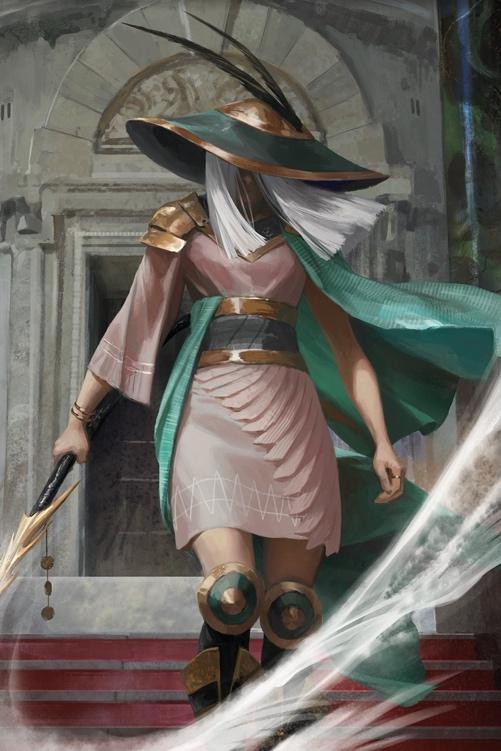
Art by Wesley Burt. Preview from Tolarian Community College.
So, that’s why we’re here this week: based on the very scientific rating system of one to five planeswalker sparks, we’ll take a look at the top fan theories for the identity of The Wanderer and figure out which—if any—are the most likely. So, in alphabetical order:
Elspeth Tirel
This has been absolutely the most common fan theory on the secret identity of WAR’s behatted hero. White-aligned knight planeswalker Elspeth Tirel remains a Magic fan favorite.
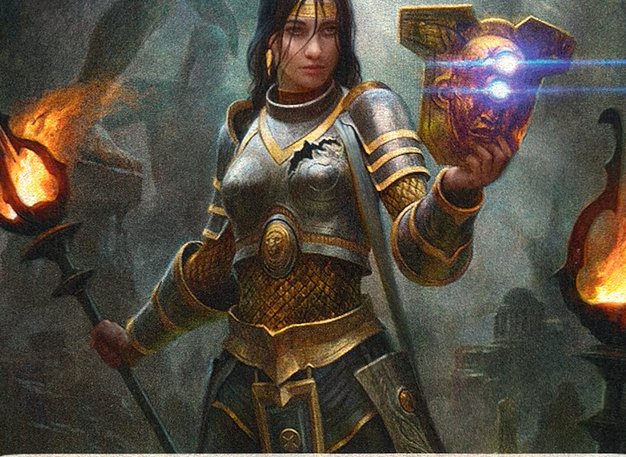
The case for the “Elspeth is The Wanderer” idea begins with her portrayal in her Mythic Edition card: here she is in Theros’s Underworld, contemplating a mask of the Returned—the faceless and memory-lacking zombie versions of those who come back to the land of the living on Theros. The theory suggests that the new planeswalker’s wide-brimmed hat obscures their face, possibly hiding a Returned mask. In addition, both have mono-white planeswalker cards and The Wanderer’s static ability is very similar to Elspeth, Knight-Errant‘s original emblem.
That said, the aesthetics don’t quite match up. First and foremost, The Wanderer’s overall vibe is more distinctly Japanese samurai-esque, while Elspeth more greatly resembles a medieval European knight. The details don’t align either. In addition, Magic Story would be doing a major disservice to its fans if one of their favorite characters returned from the dead with no explanation, only to have her spark ripped out. If Magic does bring Elspeth back, it won’t be to put her in mortal peril again right away. (Consider Levi Byrne’s interpretation of Elspeth’s potential return.)
Rating:



Emrakul/Emeria
This theory is just wild enough that it might work, so bear with me. The Wanderer, according to this school of thought, is an interplanar manifestation of the imprisoned Eldrazi titan Emrakul.
Confused already? Horrified a bit? You’re welcome’rakul.
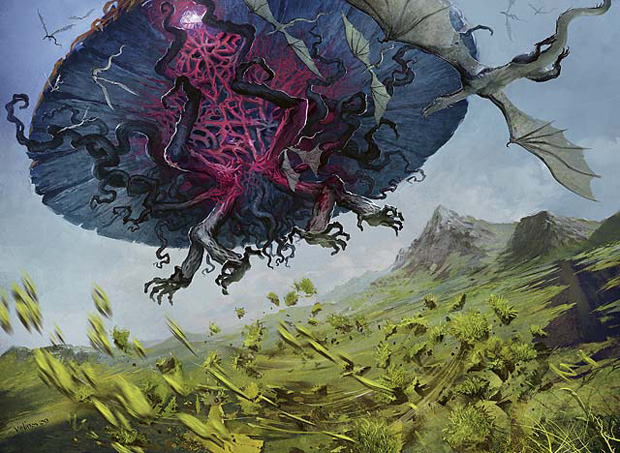
The idea is that Emrakul—despite currently being trapped in Innistrad’s moon—has projected herself as a humanoid manifestation called Emeria, who was worshipped by the Zendikari as an angel goddess of the sky, wind, and clouds. Notice any connections between these qualities and the feather textures on The Wanderer’s kimono and whip-sword? In addition, the exile ability that The Wanderer’s card has could be a reference to the Eldrazis’ annihilator abilities.
As for how she could possibly take the shape of a “planeswalker” and be on Ravnica while trapped in Innistrad’s moon? The reality-warping titan may be far more powerful than conceivable, as it’s possible her influence even reached out to Nissa during the Trial of Knowledge on Amonkhet. One of the few bits of lore we get about The Wanderer, also, describes that she can effortlessly planeswalk repeatedly, but only because she must make a concentrated effort to not be pulled from plane to plane at near random. The Eldrazi, as creatures native to the Blind Eternities (the void between worlds), seem to be able to move through the Multiverse without effort, but their reasons for visiting particular worlds are not yet known.
A lot of elements line up for this theory, and—quite honestly—it’s the one I believe the most if I have to sponsor one theory. But there’s just too much hand-waving involved to truly buy it.
Rating:




Mu Yanling
The non-doggomancer planeswalker introduced in the Global Deck Series, Mu Yanling is a blue-aligned hydromancer from the Plane of Mountains and Seas.
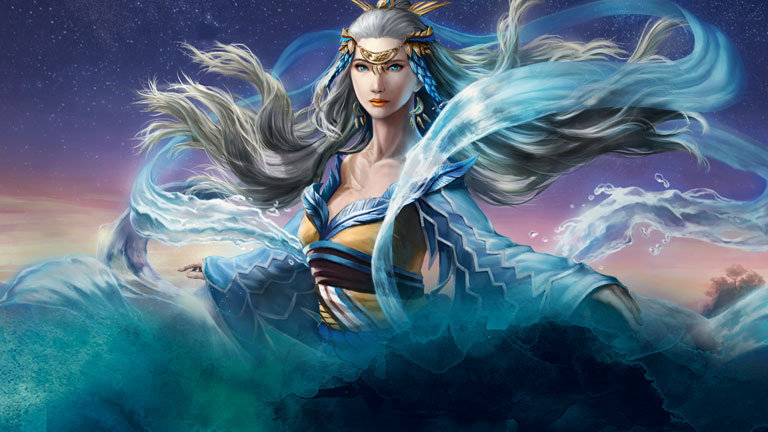
Yanling’s mana alignment and use of water magic rather than air (relating to the feather motifs on The Wanderer’s garments) seem to preclude her being the secret identity of The Wanderer.
Rating:

Serra
Serra, the angel-creating planeswalker from back in the “we were gods once” days, has been long deceased. The feather motifs on The Wanderer’s kimono and whip-sword do evoke Serra’s angelic image, and they both protect their own allies mechanically.
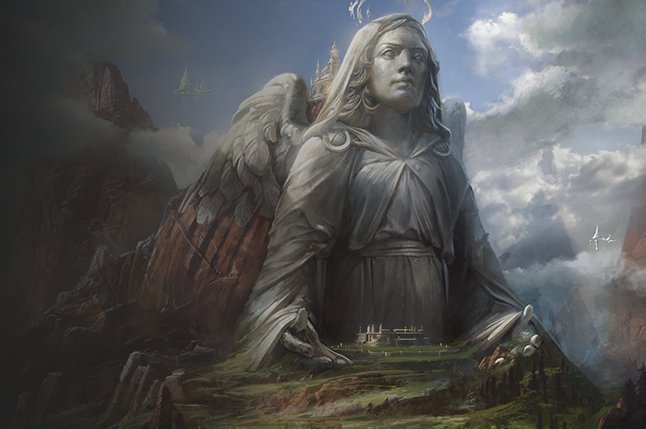
That said, there’s little else to suggest Magic Story will be resurrecting an oldwalker who died nearly 800 years ago.
Rating:



Tacenda Verlasen
I personally enjoy this idea, because I adored the novella Children of the Nameless, in which young peasant girl and songmage Tacenda from Innistrad unravels a horrific mystery while also igniting her latent planeswalker spark. Author Brandon Sanderson mentioned in a Reddit comment, however, that he concepted Tacenda as a mono-red character, though she could have some elements of green and white due to her Kessig upbringing. Still, she doesn’t seem to fit the bill as a sword-wielding warrior.
Rating:


Tetsuko Umezawa
Tetsuko Umezawa, Fugitive is a blue-aligned rogue on Dominaria who hails from the legendary Clan Umezawa. She has been suggested for The Wanderer’s secret identity due to her family’s feud with dragon planeswalker Nicol Bolas and her family’s origins on the Japanese mythology-themed plane of Kamigawa.
While another Umezawa coming to save the day from Bolas would be poetic, Tetsuko is blue-aligned, not white. Plus it has been rare for Magic to have a previously-printed legendary creature spark into a planeswalker.
Rating:

Ugin
Many of the aesthetic and mechanical reasons to believe the Emrakul/Emeria theory also apply to dragon planeswalker (and twin brother to Bolas) Ugin. That said, Ugin has been explicitly shown as one of the planeswalkers with his own stained-glass art for this set.
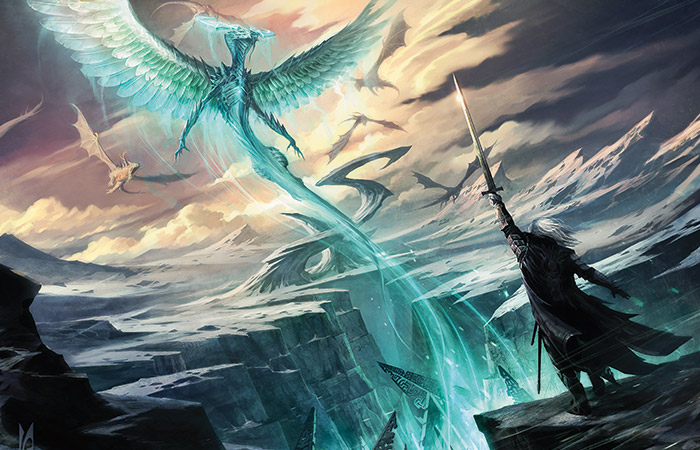
Though as of this writing not all those characters’ cards have been previewed, each actual card has mirrored its teaser depiction, and it seems unlikely Ugin will be here and have a humanoid avatar to boot.
Rating:


An Entirely New Character
Wizards of the Coast, by wrapping up the myriad Nicol Bolas plots, is showing that they want to make it to an era of Magic Story where not every plot is linked to a few “big bads” or major players. I doubt we’ll be seeing any Eldrazi stories for a while, even Ugin will probably fade into the background for a bit, and we’ll encounter new characters and new places.
Consider the archetype of the “Mysterious Stranger”, especially as shown in the Kurosawa film Yojimbo: a masterless samurai (ronin) connected to no one and nowhere wanders about until they find something to fight for, hides their true identity, efficiently destroys those who would get in their way, and then moves on. We don’t know much about The Wanderer, but they fit this mold perfectly.
… But, if I had to give my own completely unfounded theory, I’m saying that Michiko Konda and Kyodai—known as the Sisters of Flesh and Spirit—could be the identity of The Wanderer. Michiko was formerly the human daughter of an emperor on Kamigawa, and Kyodai was the child of the supreme spirit of the plane. At the culmination of the Kami War, they merged and became the Sisters, an act eerily reminiscent of the Entity merges that both Tacenda and Davriel Cane experienced that ignited their planeswalker sparks.
Or maybe The Wanderer is a new character and all of this is nonsense. Fun nonsense, but nonsense nonetheless.
Rating (my Sisters theory):


Rating (new character):





Joe Redemann is a Vorthos writer for HOTC, specializing in Magic Story and lore. He seeks to connect the stories of the Multiverse to our own daily lives, exploring social issues and philosophical questions through the lens of Magic in both his writing and podcast, Goblin Lore.

